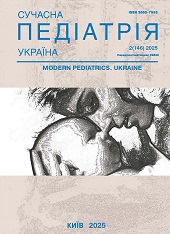Prognostic value of the IFABP marker in children with COVID-19
DOI:
https://doi.org/10.15574/SP.2025.2(146).1319Keywords:
COVID-19, IFABP, children, biomarker, gastrointestinal tract, complicated courseAbstract
Аim - to study the prognostic value of the IFABP marker regarding the occurrence of symptoms of gastrointestinal tract damage and complicated course of COVID-19 in children.
Materials and methods. We conducted a retrospective, cohort, observational study involving children with laboratory-confirmed COVID-19, aged 0 to 18 years. Patients were divided into the main and control groups according to the course of the disease. The main group included 42 patients with complicated COVID-19, and the control group included 46 patients with uncomplicated disease. During the first day of hospitalization, blood serum was collected from 88 patients to determine the level of the IFABP biomarker by enzyme-linked immunosorbent assay. The median with the interquartile interval was determined. To determine the difference in the indicators of the compared groups, the parametric Student's t-test, nonparametric Mann-Whitney and Chi-square tests were used. The Spearman rank correlation test was used to assess the relationship. An operating characteristic curve was constructed and the optimal threshold value of the marker was calculated using the Youden Index calculation method.
Results. According to calculations, in patients of the control group, IFABP was observed at a level of 15.1±3.1 ng/ml, while in children of the main group the indicator was higher, amounting to 21.7±5.5 ng/ml. When conducting a study of the correlation of the IFABP biomarker with gastrointestinal symptoms and complicated course, a correlation relationship was found. According to the results of constructing the ROC curve, the optimal threshold value of the IFABP marker for predicting the risk of developing gastrointestinal symptoms in children with COVID-19 is 29.758 ng/ml. The optimal threshold value of the IFABP marker for predicting the risk of developing a complicated course of COVID-19 in children is 30.132 ng/ml.
Conclusions. The IFABP marker has prognostic value for the occurrence of gastrointestinal symptoms and complicated course of COVID-19 in children. The optimal threshold value of the IFABP marker for predicting the risk of developing gastrointestinal symptoms and complicated course of COVID-19 in children is 29.758 ng/ml and 30.132 ng/ml, respectively.
The study was conducted in accordance with the principles of the Declaration of Helsinki. The study protocol was approved by the Local Ethics Committee for all participants. Informed consent was obtained from patients.
The authors declare no conflict of interest.
References
Cárdenas-Jaén K, Sánchez-Luna SA, Vaillo-Rocamora A et al. (2023). Gastrointestinal symptoms and complications in patients hospitalized due to COVID-19, an international multicentre prospective cohort study (TIVURON project). Gastroenterología y Hepatología (English Edition). 46(6): 425-438. https://doi.org/10.1016/j.gastre.2023.05.002; PMCid:PMC10280146
Coufal S, Kokesova A, Tlaskalova-Hogenova H, Snajdauf J, Rygl M, Kverka M. (2016). Urinary Intestinal Fatty Acid-Binding Protein Can Distinguish Necrotizing Enterocolitis from Sepsis in Early Stage of the Disease. J. Immunol. Res. 2016:5727312. Epub 2016 Mar 24. https://doi.org/10.1155/2016/5727312; PMid:27110575 PMCid:PMC4823515
Huang X, Zhou Y, Sun Y, Wang Q.(2022). Intestinal fatty acid binding protein: A rising therapeutic target in lipid metabolism. Prog Lipid Res. 87: 101178. https://doi.org/10.1016/j.plipres.2022.101178; PMid:35780915
Kholod D. (2019). Fatty-acid-binding protein as a modern marker for diagnosis and efficacy of intensive therapy of gastrointestinal insufficiency syndrome in newborns. Actual problems of the modern medicine: bulletin of ukrainian medical stomatological academy. 19(2): 95-99. https://doi.org/10.31718/2077-1096.19.2.95
Martinez J, Rodriguez Hovnanian KM, Martinez EE. (2023). Biomarkers and Functional Assays of Epithelial Barrier Disruption and Gastrointestinal Dysmotility in Critical Illness-A Narrative Review. Nutrients. 15(18): 4052. https://doi.org/10.3390/nu15184052; PMid:37764835 PMCid:PMC10535972
Piton G, Belon F, Cypriani B, Regnard J, Puyraveau M et al. (2013). Enterocyte damage in critically ill patients is associated with shock condition and 28-day mortality. Crit. Care Med. 41: 2169-2176. https://doi.org/10.1097/CCM.0b013e31828c26b5; PMid:23782971
Saia RS, Giusti H, Luis-Silva F et al (2021). Clinical investigation of intestinal fatty acid-binding protein (I-FABP) as a biomarker of SARS-CoV-2 infection. Int J Infect Dis. 113: 82-86. https://doi.org/10.1016/j.ijid.2021.09.051; PMid:34597762 PMCid:PMC8479553
Sun DL, Cen YY, Li SM, Li WM, Lu QP, Xu PY.(2016). Accuracy of the serum intestinal fatty-acid-binding protein for diagnosis of acute intestinal ischemia: A meta-analysis. Sci. Rep. 6: 34371. https://doi.org/10.1038/srep34371; PMid:27681959 PMCid:PMC5041130
Typpo KV, Larmonier CB, Deschenes J, Redford D, Kiela PR, Ghishan FK. (2015). Clinical characteristics associated with postoperative intestinal epithelial barrier dysfunction in children with congenital heart disease. Pediatr. Crit. Care Med. 16: 37-44. https://doi.org/10.1097/PCC.0000000000000256; PMid:25162512 PMCid:PMC4286428
Tyszko M, Lipińska-Gediga M, Lemańska-Perek A, Kobylińska K, Gozdzik W, Adamik B. (2022). Intestinal Fatty Acid Binding Protein (I-FABP) as a Prognostic Marker in Critically Ill COVID-19 Patients. Pathogens. 11(12): 1526. Published 2022 Dec 13. https://doi.org/10.3390/pathogens11121526; PMid:36558860 PMCid:PMC9784725
Yokoyama H, Sekino M, Funaoka H, Sato S, Araki HE et al. (2021). Association between enterocyte injury and fluid balance in patients with septic shock: A post hoc exploratory analysis of a prospective observational study. BMC Anesthesiol. 21(1): 293. https://doi.org/10.1186/s12871-021-01515-2; PMid:34814831; PMCid:PMC8609797
Downloads
Published
Issue
Section
License
Copyright (c) 2025 Modern pediatrics. Ukraine

This work is licensed under a Creative Commons Attribution-NonCommercial 4.0 International License.
The policy of the Journal “MODERN PEDIATRICS. UKRAINE” is compatible with the vast majority of funders' of open access and self-archiving policies. The journal provides immediate open access route being convinced that everyone – not only scientists - can benefit from research results, and publishes articles exclusively under open access distribution, with a Creative Commons Attribution-Noncommercial 4.0 international license (СС BY-NC).
Authors transfer the copyright to the Journal “MODERN PEDIATRICS. UKRAINE” when the manuscript is accepted for publication. Authors declare that this manuscript has not been published nor is under simultaneous consideration for publication elsewhere. After publication, the articles become freely available on-line to the public.
Readers have the right to use, distribute, and reproduce articles in any medium, provided the articles and the journal are properly cited.
The use of published materials for commercial purposes is strongly prohibited.

